供应链管理英文课件-第4章
- 格式:ppt
- 大小:171.00 KB
- 文档页数:23

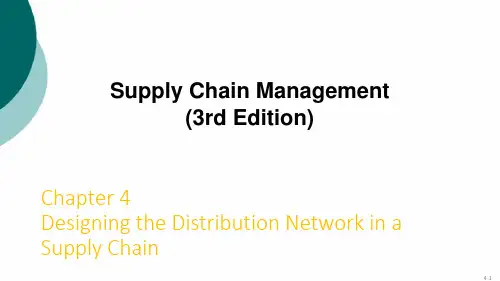
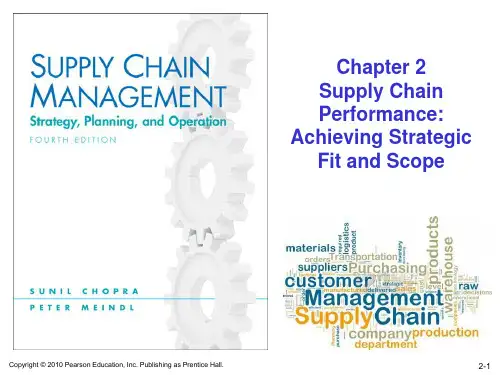
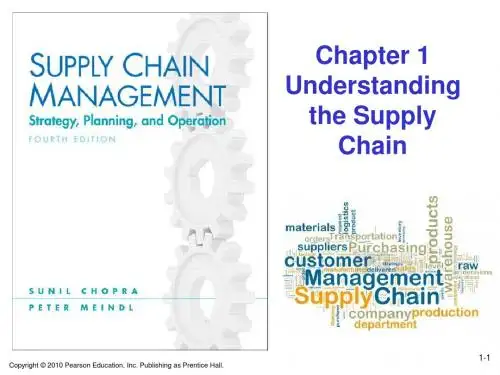
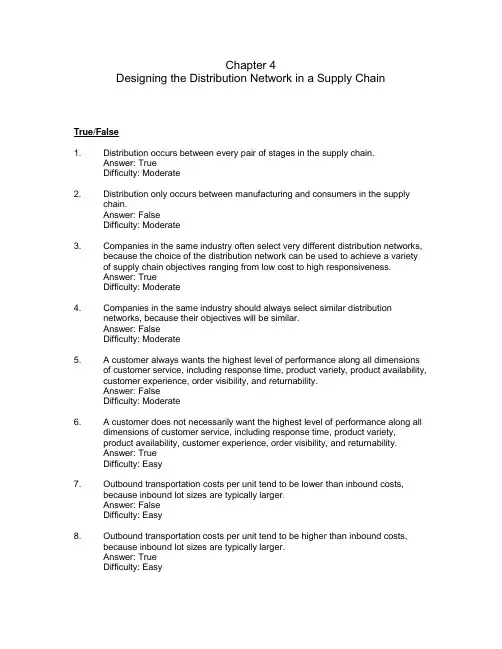
Chapter 4Designing the Distribution Network in a Supply ChainTrue/False1. Distribution occurs between every pair of stages in the supply chain.Answer: TrueDifficulty: Moderate2. Distribution only occurs between manufacturing and consumers in the supplychain.Answer: FalseDifficulty: Moderate3. Companies in the same industry often select very different distribution networks,because the choice of the distribution network can be used to achieve a varietyof supply chain objectives ranging from low cost to high responsiveness.Answer: TrueDifficulty: Moderate4. Companies in the same industry should always select similar distributionnetworks, because their objectives will be similar.Answer: FalseDifficulty: Moderate5. A customer always wants the highest level of performance along all dimensionsof customer service, including response time, product variety, product availability, customer experience, order visibility, and returnability.Answer: FalseDifficulty: Moderate6. A customer does not necessarily want the highest level of performance along alldimensions of customer service, including response time, product variety,product availability, customer experience, order visibility, and returnability.Answer: TrueDifficulty: Easy7. Outbound transportation costs per unit tend to be lower than inbound costs,because inbound lot sizes are typically larger.Answer: FalseDifficulty: Easy8. Outbound transportation costs per unit tend to be higher than inbound costs,because inbound lot sizes are typically larger.Answer: TrueDifficulty: Easy9. Transportation costs are high with drop-shipping because the average outbounddistance to the end consumer is large and package carriers are used to shipping the product.Answer: TrueDifficulty: Easy10. Transportation costs are low with drop-shipping because the average outbounddistance to the end consumer is small.Answer: FalseDifficulty: Easy11. The main advantage of in-transit merge over drop-shipping is the somewhatlower transportation cost and improved customer experience.Answer: TrueDifficulty: Moderate12. The main advantage of a distribution network with local storage is that it canlower the delivery cost and provide a faster response than other networks.Answer: TrueDifficulty: Moderate13. The main advantage of a distribution network with local storage is that it canlower the inventory and facility costs.Answer: FalseDifficulty: Moderate14. The major disadvantage of a distribution network with local storage is theincreased delivery cost.Answer: FalseDifficulty: Moderate15. The major disadvantage of a distribution network with local storage is theincreased inventory and facility costs.Answer: TrueDifficulty: Easy16. A distribution network designer needs to consider product characteristics as wellas network requirements when deciding on the appropriate delivery network.Answer: TrueDifficulty: Hard17. Only niche companies will end up using a single distribution network.Answer: TrueDifficulty: Easy18. Most companies are best served by a single distribution network.Answer: FalseDifficulty: Moderate19. Distributors add value to a supply chain between a supply stage and a customerstage if there are many small players at the customer stage, each requiring asmall amount of the product at a time.Answer: TrueDifficulty: ModerateMultiple Choice1. The steps taken to move and store a product from the supplier stage to acustomer stage in the supply chain is referred to asa. transportation.b. retailing.c. wholesaling.d. distribution.e. manufacturing.Answer: dDifficulty: Easy2. Distribution is a key driver of the overall profitability of a firm becausea. the addition of distributors only adds cost to the supply chain.b. it directly impacts both the supply chain cost and the customer experience.c. it slows down the responsiveness of the supply chain.d. it cannot be developed as a part of supply chain strategy.e. Distribution is not a key driver of profitability.Answer: bDifficulty: Moderate3. The choice of the distribution network can be used to achieve supply chainobjectives such asa. low cost.b. high responsiveness.c. high cost.d. high responsibility.e. a and b onlyAnswer: eDifficulty: Moderate4. Companies in the same industry often select very different distribution networksbecausea. some companies are poorly run.b. different companies try to avoid using the same approach.c. different companies have different objectives for their supply chain.d. all of the abovee. none of the aboveAnswer: cDifficulty: Moderate5. A poor/inappropriate distribution network cana. lead to high profitability.b. hurt the level of service customers receive while increasing cost.c. have a significant negative impact on the profitability of a firm.d. all of the abovee. b and c onlyAnswer: dDifficulty: Moderate6. Which of the following would not be the result of a poor/inappropriate distributionnetwork?a. High profitabilityb. Low level of customer servicec. High costd. Poor profitabilitye. None of the above are true.Answer: aDifficulty: Easy7. On which dimensions should the performance of a distribution network beevaluated at the highest level?a. Profitability of individual supply chain componentsb. Efficiency of overall supply chain networkc. Customer needs that are metd. Cost of meeting customer needse. c and d onlyAnswer: eDifficulty: Hard8. Which of the following are measures of customer service that are influenced bythe structure of the distribution network?a. Response timeb. Product varietyc. Product availabilityd. Customer experiencee. all of the aboveAnswer: eDifficulty: Easy9. Which of the following are measures of customer service that are influenced bythe structure of the distribution network?a. Returnabilityb. Order visibilityc. Customer experienced. Product availabilitye. all of the aboveAnswer: eDifficulty: Moderate10. Which of the following is not a measure of customer service that is influenced bythe structure of the distribution network?a. Returnabilityb. Customer experiencec. Customer maturityd. Product availabilitye. All of the above are measures of customer service.Answer: cDifficulty: Easy11. The time between when a customer places an order and receives delivery isa. response time.b. product variety.c. product availability.d. customer experience.e. order visibility.Answer: aDifficulty: Easy12. The number of different products/configurations that a customer desires from thedistribution network isa. response time.b. product variety.c. product availability.d. customer experience.e. order visibility.Answer: bDifficulty: Easy13. The probability of having a product in stock when a customer order arrives isa. response time.b. product variety.c. product availability.d. customer experience.e. order visibility.Answer: cDifficulty: Easy14. The ease with which the customer can place and receive their order as well asother aspects of value that the sales staff provides isa. customer experience.b. order visibility.c. product availability.d. response time.e. returnability.Answer: aDifficulty: Easy15. The ability of the customer to track their order from placement to delivery isa. customer experience.b. order visibility.c. product availability.d. response time.e. returnability.Answer: bDifficulty: Easy16. The ease with which a customer can return unsatisfactory merchandise and theability of the network to handle such returns isa. customer experience.b. order visibility.c. product availability.d. response time.e. returnability.Answer: eDifficulty: Easy17. The costs incurred in bringing material into a facility area. sourcing transportation costs.b. outbound transportation costs.c. crossbound transportation costs.d. inbound transportation costs.e. none of the aboveAnswer: dDifficulty: Easy18. The costs incurred in sending material out of a facility area. sourcing transportation costs.b. outbound transportation costs.c. crossbound transportation costs.d. inbound transportation costs.e. none of the aboveAnswer: bDifficulty: Easy19. Outbound transportation costs per unit tend to bea. about the same as inbound costs.b. higher than inbound costs.c. lower than inbound costs.d. neither higher or lower than inbound costs.e. none of the aboveAnswer: bDifficulty: Moderate20. As the number of facilities in a supply chain increasesa. the inventory and resulting inventory costs also increase.b. the inventory and resulting inventory costs decrease.c. the inventory increases and resulting inventory costs decrease.d. the inventory decreases and resulting inventory costs increase.e. the inventory and resulting inventory costs remain the same.Answer: aDifficulty: Moderate21. As the response time desired by the customer decreases, the required number offacilities in the distribution networka. decreases.b. remains the same.c. increases.d. increases and then decreases.e. none of the aboveAnswer: cDifficulty: Moderate22. As the number of facilities in a supply chain increases, total transportation costa. decreases.b. remains the same.c. increases.d. increases to a point and then decreases.e. decreases to a point and then increases.Answer: eDifficulty: Hard23. As the number of facilities in a supply chain increases, total facility costsa. decrease.b. remain the same.c. increase.d. increase to a point and then decrease.e. decrease to a point and then increase.Answer: cDifficulty: Moderate24. Total logistics costs for a supply chain network are a sum ofa. inventory and facility costs.b. inventory, facility, and distributor costs.c. facility, transportation, and distributor costs.d. inventory, transportation, and facility costs.e. none of the aboveAnswer: dDifficulty: Moderate25. As the number of facilities in a supply chain network increases, total logisticscosts willa. decrease.b. decrease at first and then increase.c. increase.d. increase at first and then decrease.e. neither increase or decrease.Answer: bDifficulty: Moderate26. Which of the following are key decisions in the design of a distribution network?a. Will product be delivered to the customer location or picked up from apre-ordained site?b. Will product flow through a production facility?c. Will product flow through an intermediary (or intermediate location)?d. all of the abovee. a and c onlyAnswer: eDifficulty: Moderate27. Which of the following is not a distinct distribution network design that may beused to move products from factory to customer?a. Manufacturer storage with direct shippingb. Manufacturer storage with distributor pickupc. Distributor storage with package carrier deliveryd. Distributor storage with last mile deliverye. Manufacturer/distributor storage with customer pickupAnswer: bDifficulty: Moderate28. Which of the following is not a distinct distribution network design that may beused to move products from factory to customer?a. Manufacturer storage with direct shippingb. Manufacturer storage with direct shipping and in-transit mergec. Distributor storage with package carrier deliveryd. Distributor storage with manufacturer pickupe. Retail storage with customer pickupAnswer: dDifficulty: Moderate29. In which distribution network design is product shipped directly from themanufacturer to the end customer, bypassing the retailer (who takes the orderand initiates the delivery request)?a. Manufacturer storage with direct shippingb. Manufacturer storage with direct shipping and in-transit mergec. Distributor storage with package carrier deliveryd. Distributor storage with last mile deliverye. Manufacturer/distributor storage with customer pickupAnswer: aDifficulty: Easy30. Which distribution network is also referred to as drop-shipping with productdelivered directly from the manufacturer to the customer location?a. Manufacturer storage with direct shippingb. Manufacturer storage with direct shipping and in-transit mergec. Distributor storage with package carrier deliveryd. Distributor storage with last mile deliverye. Manufacturer/distributor storage with customer pickupAnswer: aDifficulty: Moderate31. Advantages of manufacturer storage with direct shipping includea. the ability to reduce cost of inventory by centralizing inventories at themanufacturer.b. offering the manufacturer the opportunity to postpone customization untilafter the customer order has been placed.c. supply chains save on the fixed cost of facilities, because the need forother warehousing space in the supply chain has been eliminated.d. providing a good customer experience in the form of delivery to thecustomer location.e. all of the aboveAnswer: eDifficulty: Moderate32. Which of the following is an advantage of manufacturer storage with directshipping?a. Transportation costs are low because the average outbound distance tothe end consumer is small and package carriers are used to shipping theproduct.b. Supply chains save on the fixed cost of facilities, because the need forother warehousing space in the supply chain has been eliminated.c. Response times tend to be small because the order has to be transmittedfrom the retailer to the manufacturer.d. Order tracking is easy to implement because of the complete integrationof information systems at both the retailer and the manufacturer.e. The handling of returns is likely to be simple and inexpensive, improvingcustomer satisfaction.Answer: bDifficulty: Moderate33. Disadvantages of manufacturer storage with direct shipping includea. Transportation costs are high because the average outbound distance tothe end consumer is large and package carriers are used to shipping theproduct.b. Response times tend to be large because the order has to be transmittedfrom the retailer to the manufacturer and shipping distances are onaverage longer from the manufacturer’s centralized site.c. Order tracking becomes harder to implement because it requirescomplete integration of information systems at both the retailer and themanufacturer.d. The handling of returns is likely to be difficult and more expensive, hurtingcustomer satisfaction.e. all of the aboveAnswer: eDifficulty: Moderate34. Which of the following would be a disadvantage of manufacturer storage withdirect shipping?a. The ability to reduce cost of inventory by centralizing inventories at themanufacturer.b. The manufacturer has to postpone customization until after the customerorder has been placed.c. Supply chains have to eliminate other warehousing space to save on thefixed cost of facilities.d. Response times tend to be large because the order has to be transmittedfrom the retailer to the manufacturer and shipping distances are onaverage longer from the manufacturer’s centralized site.e. Provides a good customer experience when a single order containingproducts from several manufacturers is delivered in partial shipments.Answer: dDifficulty: Moderate35. Which distribution network design is similar to pure drop-shipping, except thatpieces of the order coming from different locations are combined so that thecustomer gets a single delivery?a. Manufacturer storage with direct shippingb. Manufacturer storage with direct shipping and in-transit mergec. Distributor storage with package carrier deliveryd. Distributor storage with manufacturer pickupe. Retail storage with customer pickupAnswer: bDifficulty: Moderate36. The main advantage of in-transit merge over drop-shipping isa. the ability to reduce cost of inventory by centralizing inventories at themanufacturer.b. supply chains save on the fixed cost of facilities, because the need forother warehousing space in the supply chain has been eliminated.c. somewhat lower transportation cost and improved customer experience.d. order tracking is easy to implement because of the complete integrationof information systems at both the retailer and the manufacturer.e. the handling of returns is likely to be simple and inexpensive, improvingcustomer satisfaction.Answer: cDifficulty: Moderate37. The major disadvantage of in-transit merge compared to drop-shipping isa. transportation costs are high because the average outbound distance to theend consumer is large and package carriers are used to shipping the product.b. response times tend to be large because the order has to be transmitted fromthe retailer to the manufacturer and shipping distances are on average longerfrom the manufacturer’s centralized site.c. order tracking becomes harder to implement because it requires completeintegration of information systems at both the retailer and the manufacturer.d. the additional effort during the merge itself.e. the handling of returns is likely to be difficult and more expensive, hurtingcustomer satisfaction.Answer: dDifficulty: Easy38. Which distribution network design is being used when inventory is not held bymanufacturers at the factories, but is held by distributors/retailers in intermediate warehouses and package carriers are used to transport products from theintermediate location to the final customer?a. Manufacturer storage with direct shippingb. Manufacturer storage with direct shipping and in-transit mergec. Distributor storage with package carrier deliveryd. Distributor storage with manufacturer pickupe. Retail storage with customer pickupAnswer: cDifficulty: Easy39. Which of the following is an advantage of distributor storage with carrier delivery?a. Inventory cost is higher than with manufacturer storage.b. Product variety is lower than with manufacturer storage.c. Order visibility for the customer is easier than with manufacturer storage.d. Higher cost to provide the same level of product availability asmanufacturer storage.e. Cost of facilities and handling is somewhat higher than manufacturerstorage.Answer: cDifficulty: Moderate40. Which of the following is a disadvantage of distributor storage with carrierdelivery?a. Information infrastructure is simpler than manufacturer storage.b. Response time is faster than with manufacturer storage.c. Returnability is easier than with manufacturer storage.d. Product variety is lower than with manufacturer storage.e. Transportation cost is lower than with manufacturer storage.Answer: dDifficulty: Moderate41. Which distribution network design is being used when the distributor/retailerdelivers the product to the customer’s home instead of using a package carrier?a. Manufacturer storage with direct shippingb. Manufacturer/distributor storage with customer pickupc. Distributor storage with package carrier deliveryd. Distributor storage with last mile deliverye. Retail storage with customer pickupAnswer: dDifficulty: Moderate42. Which of the following is an advantage of distributor storage with last miledelivery?a. More expensive to provide product availability than any other optionexcept retail stores.b. Inventory cost is higher than distributor storage with package carrierdelivery.c. Response time is very quick ranging from same day to next day delivery.d. Transportation cost is higher than any other distribution option.e. Returnability is harder and more expensive than a retail network.Answer: cDifficulty: Easy43. Which of the following is a disadvantage of distributor storage with last miledelivery?a. Transportation cost is higher than any other distribution option.b. Information cost is similar to distributor storage with package carrierdelivery.c. Customer experience is very good, particularly for bulky items.d. Returnability is easier to implement than other options.e. Order traceability is less of an issue and easier to implement thanmanufacturer storage or distributor storage with package carrier delivery.Answer: aDifficulty: Hard44. Which distribution network design is being used when inventory is stored at themanufacturer or distributor warehouse but customers place their orders online or on the phone and then come to designated pickup points to collect their orders?a. Manufacturer storage with direct shippingb. Manufacturer/distributor storage with customer pickupc. Distributor storage with package carrier deliveryd. Distributor storage with last mile deliverye. Retail storage with customer pickupAnswer: bDifficulty: Moderate45. Which of the following is an advantage of manufacturer/distributor storage withcustomer pickup?a. Facility costs can be very high if new facilities have to be built.b. Transportation cost is lower than the use of package carriers, especially ifusing an existing delivery network.c. Order visibility is difficult but essential.d. Product variety is similar to other manufacturer or distributor storageoptions.e. Significant investment in information infrastructure required.Answer: bDifficulty: Moderate46. Which of the following is a disadvantage of manufacturer/distributor storage withcustomer pickup?a. Customer experience is lower than other options because of the lack ofhome delivery.b. Response time is similar to package carrier delivery with manufacturer ordistributor storage.c. Returnability is somewhat easier given that pickup location can handlereturns.d. Product availability is similar to other manufacturer or distributor storageoptions.e. Facilities costs are lower if existing facilities are used.Answer: aDifficulty: Hard47. Which distribution network design is being used when inventory is stored locallyat retail stores and customers walk into the retail store or place an order online or on the phone and pick it up at the retail store?a. Manufacturer storage with direct shippingb. Manufacturer/distributor storage with customer pickupc. Distributor storage with package carrier deliveryd. Distributor storage with last mile deliverye. Retail storage with customer pickupAnswer: eDifficulty: Easy48. Which of the following is an advantage of retail storage with customer pickup?a. Inventory cost is higher than all other options.b. Transportation cost is lower than all other options.c. Facilities and handling costs are higher than other options.d. Product variety is lower than all other options.e. Product availability is more expensive to provide than all other options.Answer: bDifficulty: Moderate49. Which of the following is a disadvantage of retail storage with customer pickup?a. Returnability is easier than other options given that pickup location canhandle returns.b. Inventory cost is higher than all other options.c. Transportation cost is lower than all other options.d. Facilities and handling costs are lower than other options.e. Product variety is higher than all other options.Answer: bDifficulty: Moderate50. Distributors add value to a supply chain between a supply stage and a customerstagea. if there is a small number of customers requiring a large amount ofproduct.b. if there is a large number of customers requiring a large amount ofproduct.c. if there are many small players at the customer stage, each requiring asmall amount of the product at a time.d. if there are a few large players at the customer stage, each requiring alarge amount of the product at a time.e. Distributors do not add value to a supply chain.Answer: cDifficulty: Moderate51. Improvement in supply chain performance at the result of distributors occurs forwhich of the following reasons?a. Reduction in transportation cost because of LTL shipments frommanufacturers to distributor.b. Reduction in outbound transportation cost because the distributorcombines products from many customers into a single outbound shipment.c. Reduction in inventory costs because distributor disaggregates safetyinventory rather than aggregating at each retailer.d. A more stable order stream from distributor to manufacturer (compared toerratic orders from each retailer) allows manufacturers to lower cost byplanning production more effectively.e. By carrying inventory closer to the point of sale, manufacturers are able toprovide a better response time than distributors can.Answer: dDifficulty: Hard52. Which of the following statements about distribution networks is true?a. The ownership structure of the distribution network can have as big animpact as the type of distribution network.b. The choice of a distribution network has very long-term consequences.c. The choice of an exclusive distribution strategy may be advantageous.d. All of the above are true.e. None of the above are true.Answer: dDifficulty: HardEssay/Problems1. Explain the measures of customer service that are influenced by the structure ofthe distribution network.Answer: Response time is the time between when a customer places an orderand receives delivery.Product variety is the number of different products/configurations that acustomer desires from the distribution network.Availability is the probability of having a product in stock when a customer order arrives.Customer experience includes the ease with which the customer can place and receive their order. It also includes purely experiential aspects, such as thepossibility of getting a cup of coffee and the value that the sales staff provides.Order visibility is the ability of the customer to track their order from placementto delivery.Returnability is the ease with which a customer can return unsatisfactorymerchandise and the ability of the network to handle such returns.Difficulty: Moderate2. Explain how the design of the distribution network affects the cost of the foursupply chain drivers.Answer: As the number of facilities in a supply chain increases, the inventory and resulting inventory costs also increase. To decrease inventory costs, firms try toconsolidate and limit the number of facilities in their supply chain network.Outbound transportation costs per unit tend to be higher than inbound costsbecause inbound lot sizes are typically larger. Increasing the number of。
![供应链管理(英文课件)Chapter4-Inventory Management[精]](https://uimg.taocdn.com/89b4cb2afe4733687f21aa15.webp)
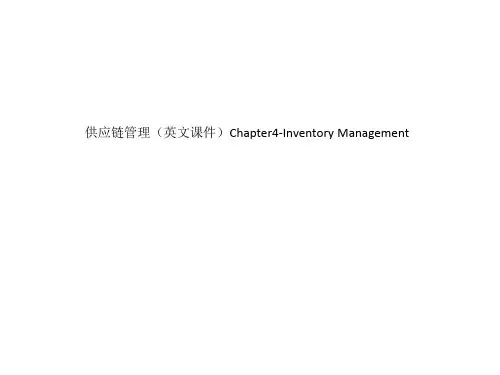
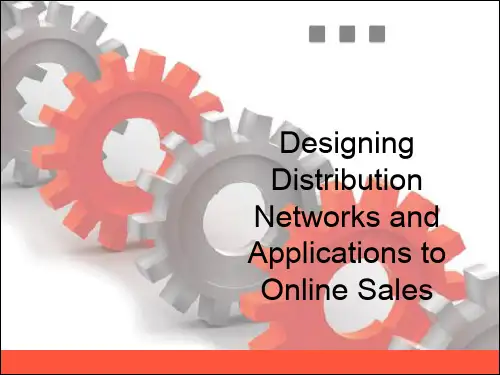
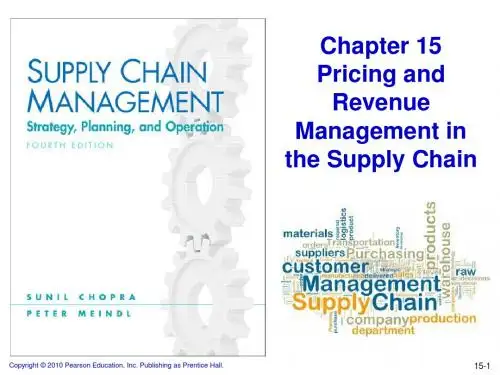
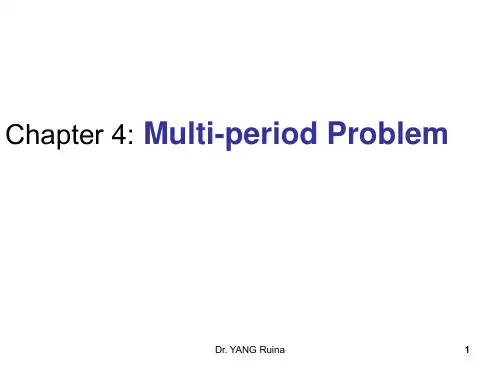
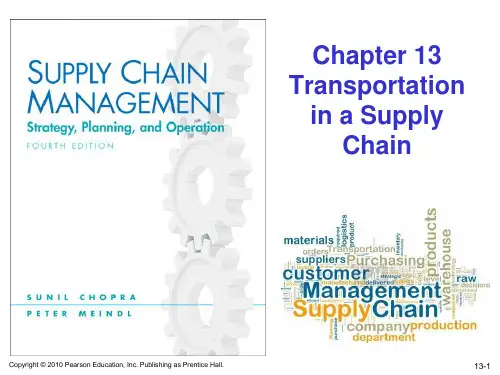
CASE STUDY—Blue Nile and Diamond RetailingTeaching ObjectivesThe learning objectives of the case are to (1) understand the link between supply chain structure and financial performance, (2) identify key drivers of supply chain performance and how they affect a firm's ability to respond during periods of strong or weak demand, and (3) develop the alignment between supply chain structure and strategic position for a firm.To this end, the case highlights the supply chain structures and performances of three firms in the diamond retailing industry: Blue Nile, Zales, and Tiffany. Blue Nile’s supply chain structure is geared toward a pure centralized e-business; Zales sells merchandise primarily through stores but recently added an online channel; and Tiffany also uses an online channel but most of its diamond and other high-end products are sold through stores. The case is designed to foster discussion of the three supply chain str uctures and encourage students to evaluate the firms’ performance in terms of components of customer service such as response time, product variety, product availability, customer experience, order visibility, and returnability, coupled with cost factors that includeinventory, transportation, information, and facilities.Study Questions1. What are some key success factors in diamond retailing? How do Blue Nile, Zales, and Tiffany compare on those dimensions?As with most retailing, the key success factors in diamond retailing can be measured by customer service factors and cost factors. Given the varied supply chain components and supply chain costs, Blue Nile has a distinct advantage in product variety and product availability since customers can “build their own ring” by choosing from an inventory of about 75,000 stones. Customers purchasing at Tiffany and, until recently, at Zales have been limited to the inventory available at the store. Customers who are comfortable making large purchases online will find the low-pressure purchasing experience at Blue Nile, supported by the educational Web site, salaried sales support, and thirty-day return guarantee, appealing. Given that the jewelry is made to order, clients at Blue Nile must be willing to wait to receive their orders, unlike at Tiffany or Zales.The Tiffany brand is very strong and well established. It is associated with glamour, trust, and customer service. These associations allow the company to sell at higher margins than its competitors. Diamond and other high-end jewelry purchases are expensive, and many customers will trade off other factors for the Tiffany customer experience when making such purchases. Moreover, when spending thousands of dollars for a single item, customers often want to see and feel what they are buying.Zales does not have the product variety and availability that Blue Nile provides, nor does it have the brand name advantage that Tiffany enjoys. The weaker brand is reflected in the firm’s margins, which are lower th an those of Tiffany. Blue Nile’s focus on low prices is reflected in the lower margins it has relative to both Zales and Tiffany. Blue Nile operates out of onewarehouse, with its entire inventory at this facility. The inventories at both Tiffany and Zales are disaggregated through their stores. High-end jewelry items are high-priced, have relatively low demand, and have high demand variability. Such items realize the most savings in inventory holding cost through lower safety stock inventory when the inventory is aggregated. Further, since items sold through the Blue Nile Web site are customized, the inherent postponement allows the company to keep inventory aggregated longer, thus reducing safety inventory even more. While Blue Nile’s inventory-to-sales ratio is around 6 percent, the ratios for both Tiffany and Zales are about 40 percent. Blue Nile’s supply chain structure also gives it a major advantage in facility costs.Blue Nile operates primarily from one warehouse in the United States. Both Zales and Tiffany operate many stores, often in high-priced locations. In addition to stores all over the world, Tiffany has manufacturing facilities, a retail service center that supplies stores, and diamond processing centers in seven countries. While Tiffany has advantages from being vertically integrated, Blue Nile operates on a very low fixed-cost structure. Blue Nile’s property and equipment to net sales ratio was 2.37 percent in 2007, while Tiffany’s was more than 25 percent, down from 35 percent in 2006, and Zales’ was close to 14 percent. Blue Nile also has an advantage in facility operatingcosts. Because customers design, select, and order jewelry on the Web site, the company does not incur the level of human resources costs in the form of sales staff that Tiffany and Zales do. Transportation costs, as with most e-retailers, are higher at Blue Nile than at Tiffany or Zales. The outbound transportation distance and hence costs and time tend to be much higher when inventories are aggregated, as is the case at Blue Nile. In the case of Tiffany and Zales, some economies of scale can still be realized on inbound transportation at all downstream stages of the supply chain until the merchandise hits retail stores, and the customer takes care of the last mile of outbound transportation costs.The companies do not seem to differentiate themselves from each other on any other customer service components, such as time to market, order visibility and returnability, or cost of information.2. What do you think of the fact that Blue Nile carries about 30,000 stones priced at $2,500 or higher whereas almost 60 percent of the products sold from the Tiffany website are priced around $200? Which of the two product categories is better suited to the online channel? There are different reasons why these two firms carry very different types of items on their Web sites. In the case of Blue Nile, the primary reasons could be the savings in inventory holding cost due to lower safety stocks and the broad product variety and product availability that the firm can offer customers. Stones priced at $2,500 or higher are unique, high-value items with relatively low demand and high demand variability. The high demand variability necessitates carrying larger safety stock in order to meet required customer service levels. Given the high price of the stones, the cost of holding them in inventory is proportionally higher. Aggregating inventory reduces the amount of safety stock required since the demand variability is less than in a disaggregated scenario. By aggregating the inventory in the online channel, Blue Nile alsobroadens the product availability and variety available to customers. It is a smart move for Blue Nile to aggregate and carry its high-priced products with low demand and high demand variability on an online channel.The Tiffany brand is built on the glamour, luxury, and quality that customers perceive when visiting a Tiffany store. This perception is a result of both the products and the service. The company’s invento ry includes a wide variety of items ranging from very high-end diamond jewelry to basic but elegant tableware. Tiffany has stores as small as 1,300 square feet, and in 2008 the firm began opening stores of about 2,000 square feet selling high-margin products in affluent U.S. areas. Given the strategic importance of the brand image, the breadth of inventory, and the push toward smaller facilities and lower cost, it makes sense for Tiffany to position the high-end luxury products at the store and move the D items to the online channel. This allows it to utilize the limited facility space to highlight the high-end items and customer service and offer the lower-end items online, where product substitution can be used as means of aggregating inventory and lowering safety stocks for the D items. This structure, however, puts Tiffany at a cost disadvantage relative to Blue Nile because Tiffany decentralizes its high-value items with low demand and high variety while centralizing its lower-value items. Such a cost disadvantage can be justified as long as Tiffany can maintain its strong brand and associate it with the store experience.3. What do you think of Tiffany’s decision to not sell diamonds online? What do you think of Blue Nile’s growth into the non-engagement category?Given that Tiffany’s key strength is its brand (reflected in the high gross margin it obtains through high prices), it seems appropriate that Tiffany does not sell diamonds online. While this approach does increase inventory costs at Tiffany (because the stones have to be held at decentralized stores), it keeps up the impression that somehow a Tiffany diamond is unique and worth paying extra for. Once Tiffany starts selling its diamonds online, it will have to explain the diamonds in terms of the 4 Cs, making a price comparison with Blue Nile more obvious. Selling diamonds online is likely to increase downward price pressure on Tiffany.Blue Nile’s growth into the non-engagement category, especially in the form of lower cost goods such as silver cuff-links, could present some challenges. It makes sense if the person buying an expensive engagement ring also decides to buy the other items that are less expensive. If however, people st art buying only the less expensive items, Blue Nile’s promise of free shipping is likely to cause profit problems for the company. Free shipping on a diamond worth $6,000 is one thing but free shipping on silver cuff links worth less than $100 will hurt profits.4. Given that Tiffany stores have thrived with their focus on selling high-end jewelry, what do you think caused the failure of Zales upscale strategy in 2006? What products should Zales focus on?Zales’ upscale strategy was in response to fierce competition it was facing from mass merchant department stores such as Walmart, national chain department stores such as JCPenney, and home shopping networks. Middle America had been Zales’ target market since its founding in 1924. A large portion of the company’s revenue came from value-oriented customers whofrequented malls. The success of the Zales brand was built on the perception of the good value one got for the money, but with that came the perception of being inexpensive. While one can see why the company decided on the competitive repositioning, one must question the implementation. It takes much time and effort to educate new customers and transform a brand. Zales tried to make too many radical changes in too little time. The firm drastically changed its portfolio of products, 15 percent of the suppliers in the supply chain network were new and included new overseas vendors, and holiday promotions and monthly payment plans were eliminated, to name a few c hanges. All this resulted in the firm’s losing not only its core customer base but also sales due to delays in bringing merchandise in on time and not making inroads into new target markets.The basic premise of its strategy to move into selling high-end jewelry through its stores is also questionable. Given that it has a much weaker brand than Tiffany; Zales’ strategy of bringing high-end jewelry to its stores raised its inventory costs without raising its margins enough to offset this increase. Zales’ inventories in FY 2006, when it tried the high-end strategy, rose to 47 percent of sales, even higher than Tiffany’s; its margins, however, remained lower than Tiffany’s. Poor execution hurt it further, but given that its brand is weaker than Tiffany’s, one can question whether such a strategy would have had any chance of success even in the long term.Zales is better off focusing on products that are lower end and somewhat more standardized. It will continue to be challenging for Zales to compete with the likes of Walmart and Costco in this space.5. Which of the three companies do you think was best structured to deal with weak economic times?A lean and nimble structure is an advantage in weak economic times. Blue Nile has a distinct advantage in this regard with its very low fixed-cost structure compared to Tiffany and Zales. Property and equipment to net sales ratios are 2.38, 13.93, and 25.46 percent for Blue Nile, Zales, and Tiffany, respectively. Both Zales and Tiffany are contractually tied up in many medium- to long-term leases for their facilities. The selling, general, and administrative expenses at Tiffany and Zales are about four times those incurred at Blue Nile. Much of this discrepancy can be attributed to the costs of operating stores. Blue Nile also has a very low investment in inventory compared to the other two companies. The cost of sales at Blue Nile is higher, but this can attributed to the lower margins and the higher cost of outbound distribution. The low cost structure at Blue Nile is well suited for times when demand shrinks in the industry. Blue Nile should take advantage of its low cost structure and lower prices to get more market share.Zales is perhaps in the weakest position to handle weak economic times, given the inventory write-off it had to take when its high-end strategy failed. With tightened credit, Zales may find it difficult to survive. Tiffany certainly has the strength to survive but is hurt significantly by dropping sales, given its relatively high fixed costs.6. What advice would you give to each of the three companies regarding their strategy and structure?Blue Nile has a strategy that focuses on lower prices on a large variety of high-end stones that aligns very well with its centralized structure. Its marketing focus on convincing customers that the four Cs and third-party validation are the key ingredients when valuing a diamond is also well aligned with its structure, which does not allow customers to touch and see the stone before buying. Given its s ignificant cost advantages and customers’ tendency to try to save money during difficult times, Blue Nile has a significant opportunity in this downturn. Blue Nile can take an aggressive position, emphasizing its lower prices with similar quality to very high-end diamond retailers. Although this is a difficult message to sell in general, it may be easier in the difficult economic environment of 2009.For Zales, positive recommendations are more difficult to make. From a financial perspective, Zales needs to get control of its inventories. One way to do this is to centralize more of its expensive diamond inventory, making it available to stores as needed. Lower-value diamonds could be stocked and sold from retail stores. For higher-end diamonds, rings with imitation stones could be used to help customers select a style, followed by having the real diamond installed later at a central location and shipped to the store for customer pick-up. Zales’ ideal situation seems to be one in which it stocks and sells lower-cost products from decentralized locations with higher-value stones centralized and provided on demand.Tiffany finds itself in a bit of a bind. It cannot centralize its high-end stones because that would conflict with its brand image. Pricing pressure at retail is likely to continue with the growth of Blue Nile at the high end and retailers such as Walmart and Costco at the lower end. As a result, Tiffany has to continue working hard to maintain its brand image. Its move into the wholesale part of the diamond business has potential pluses—it gives the company the wholesale margin and could give it some form of exclusivity on its stones. For now, its sources of stones are very similar to those of its competitors.。